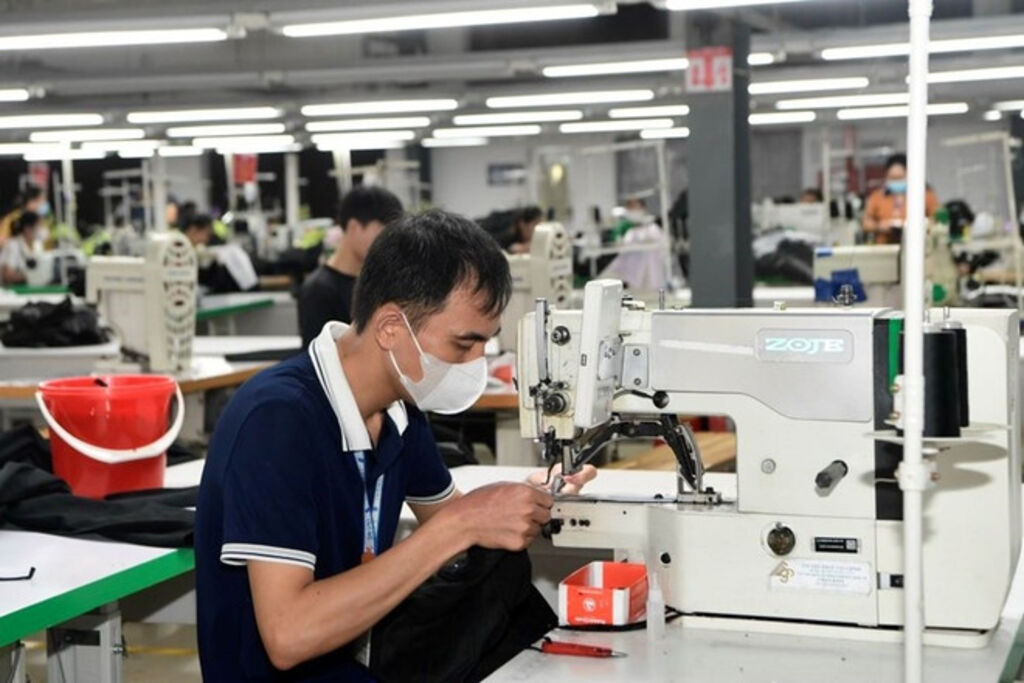 |
| Production activities at Xuan Hoa Vietnam JSC, Phu Tho province__Photo: VNA |
After five years of implementation, the EU–Vietnam Free Trade Agreement (EVFTA) has not only generated substantial economic value but also demonstrated its strategic significance in deepening Vietnam’s integration process, helping elevate the country’s standing on the international stage.
Amid intensifying geo-economic competition and complex supply chain shifts, the EVFTA has emerged as a pillar of Vietnam’s open-door policy and sustainable development strategy.
Vietnam becomes the EU’s leading partner in ASEAN
Entering into force on August 1, 2020, the EVFTA eliminated over 70 percent of tariffs immediately, with nearly 99 percent of remaining tariffs to be phased out over time. Beyond tariff cuts, the deal expands market access, protects intellectual property rights, enhances regulatory transparency, and creates favorable conditions for businesses on both sides to fully capitalize on trade opportunities. Bilateral trade between Vietnam and the EU reached USD 298 billion from August 2020 to May 2025, accounting for nearly 40 percent of their accumulated turnover over the past three decades. This underscores the EVFTA’s catalytic role in market expansion and strengthening economic ties. Today, Vietnam is the EU’s largest goods trading partner in ASEAN and its 16th globally.
According to Nguyen Anh Son, Director of the Import–Export Department at the Ministry of Industry and Trade, the agreement has delivered positive outcomes, opening up new markets for Vietnam’s footwear, farm produce, and fruit, while enabling businesses to access advanced technologies and modern equipment. It also facilitates Vietnam’s institutional, policy, and legal reforms towards greater transparency and alignment with international practices.
The EU is now Vietnam’s third-largest export market and fourth-largest import source, supplying strategic products including high-tech machinery, transport equipment, pharmaceuticals, and green technologies. With a population of over 100 million and a workforce exceeding 55 million, Vietnam has become a “strategic ecosystem” for European businesses seeking deeper integration into new supply chains.
A survey by EuroCham Vietnam reveals that not only large corporations but also SMEs are taking advantage of EVFTA preferences, with the proportion of firms citing tariff reductions as a key advantage increasing from 29 percent in Q2 2024 to 61 percent in Q2 2025.
 |
| Production activities at Tien Son Thanh Hoa Group JSC__Photo: VNA |
Rules of origin – a challenge to overcome
With a GDP of USD 29 trillion (purchasing power parity - PPP) and more than 450 million consumers, the EU is the world’s largest single economic bloc. Its per capita GDP surpassed USD 43,000 in 2024 (World Bank), reflecting strong purchasing power and diverse demand – an ideal market for Vietnam’s high-quality goods, ranging from agricultural and processed food to textiles, furniture, and technology.
However, opportunities come with challenges. Rules of origin remain the biggest barrier, as most input materials for Vietnam’s key export sectors are imported from outside the bloc, complicating proof of origin requirements. The EVFTA permits cumulation with certain partners; however, the procedures can be complex, and domestic supply chains are still poorly interconnected.
Ngo Chung Khanh, Deputy Director General of the Multilateral Trade Policy Department at the Ministry of Industry and Trade, warned that without improvements in meeting technical standards and rules of origin, Vietnamese products risk losing their competitiveness, especially as the EU accelerates FTA negotiations with other countries.
In 2024 alone, Vietnam issued over 1.8 million preferential Certificates of Origin (C/O) with an export value exceeding USD 100 billion. Notably, 56 percent of EU firms in Vietnam file C/Os monthly, underscoring their critical role in securing tariff benefits and maintaining credibility with partners.
Many businesses have called for full digitalization of the C/O process, adoption of a single electronic declaration system, shorter processing times, enhanced transparency, and stronger supply chain data connectivity. They also stressed the need for targeted technical support programs to help firms master documentation, validate origin, and stay updated on evolving EU standards.
The EVFTA has opened a “big door,” but how far and fast Vietnam can move through it depends first and foremost on its internal capacity, proactiveness, and adaptability. To maximize opportunities, Vietnamese enterprises must not only innovate technologically and improve governance but also persistently build stronger domestic supply chains, increase localization, and pursue sustainable development.- (VNA/VLLF)









